|
It takes a
while to download this page due to all the photos - but it´s
worth waiting for! |
 When
most people think of Spain, the symbol they associate most with
the country is the fighting bull. But there is another animal that
has been of far greater importance to the Iberians throughout the
centuries – the horse. When
most people think of Spain, the symbol they associate most with
the country is the fighting bull. But there is another animal that
has been of far greater importance to the Iberians throughout the
centuries – the horse.
By
Andrea Taylor
Photographs by Ricardo Delgado
Andrea Taylor at the
Real Feria in Seville |
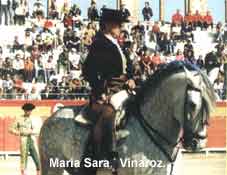
As in all civilisations, the horse has been employed for centuries as a weapon of war, a means
of transport and work, and for sport. The most characteristic of
Spain’s horses is the Pure Spanish Thoroughbred, or Andalusian. They
date back in origin to the very first wild horses tamed by the Iberians,
and legend claims that they are directly descended from the mythical
flying horse, Pegasus. They were left to run free until the Roman
invasion of 200BC, when they were tamed for breeding, but after the
Romans retreated, they were left to run wild again
Fighting the Moors taught Spaniards the importance of producing good
horses, but not until 1571 did Phillip II found the first Royal Stud
farm, at Córdoba. Babieca, the legendary horse that carried El Cid
across the battlefields, was an Andalusian, as were the horses ridden on
the New World expeditions by the Spanish Conqueror Hernán Cortés,
which were mistaken by the indigenous natives for gods. Many European
Kings and leaders chose this breed for their courage, speed and
temperament, and the Natural History museum of Paris still exhibits the
skeleton of a notorious Andalusian horse once ridden to victory by
Napoleon.
Doma Campera, or Andalusian Dressage,
is the style of riding favoured throughout Spain and Portugal, and
exhibitions and competitions are held frequently. Nowhere is it seen to
better advantage than during the yearly town fairs in Andalusia, where
hundreds of beautiful horses ridden by elegant women and men wearing the
traditional traje corto, some
of the men carrying women behind them clad in the finery of their
flamenco dresses, parade through the fairground providing an
unforgettable spectacle of tradition and colour. There are carriages,
too, pulled by teams of up to four pairs of perfectly matched animals
and driven by coachmen in outfits derived from those worn by the
Andalusian bandits in the 19th century. During the major fairs such as
Seville, Ronda, or Jerez, special competitions are held to test the
skill of the drivers.
|

Rejoneadores in the
bullring of Ronda.
|
Horses are
also a major part of the romerías or pilgrimages which taken place
all over Spain, the most famous being that of El Rocío where thousands
of pilgrims on foot, on horseback or in ox-drawn wagons join together
for a week of singing and dancing before they reach their destination.
The horse does, naturally, also have many connections to the fighting
bull throughout Spain and Portugal, and not only for use in the ring by
the picadors as many people might imagine. The horse is used on bull
breeding ranches for inspecting and herding the cattle, and for the
testing of young bulls in the ritual known as acoso y derribo where calves are pursued on horseback by herdsmen
armed with long poles. The young bull is knocked to the ground several
times to test his strength and reaction and it is in this way that the
preliminary selection is made of the animals which will go on to be
faced by top matadors all over the peninsula.
Finally, we
come to the rejoneo, or
bullfights on horseback. Many people outside of Spain do not even
realise that it exists, when in fact, it is the pure original form of
the modern Spanish bullfight. From early times, young noblemen would go
out on horseback to hunt the wild bulls, which populated the forests and
plains of Iberia. Some historians even claim that Julius Caesar once
killed a bull from horseback in the province of Seville. Over the years,
it evolved into a more ritual, organised public spectacle and was held
in town squares all over the peninsula. In the 16th Century, Francisco
Romero is credited with being the first person to fight a bull on foot,
and from then on, rejoneo
became unfashionable, while the ”new style” of bullfighting that
most people regard as traditional rapidly spread throughout Spain. Rejoneo today is still practiced more or less in it’s original
form, and is enjoying a new wave of popularity. Many rejoneadores still come from rich or noble families, for it is a
time consuming and expensive hobby for all but the chosen few who reach
the
top. It is still the main type of bullfight in Portugal,
where the riders wear the elaborate embroidered silk coats and plumed
hats of 17th century noblemen. In Spain, they wear the typical
Andalusian country traje corto
of wide-brimmed hat, short jacket, boots, and tight split-legged
trousers protected by zahones,
wide, heavily decorated leather chaps. It is a beautiful and daring
spectacle and the horses, usually Andalusian or Portuguese thoroughbreds,
are some of the finest in Iberia.
It takes many years to prepare a horse for the ring, from
the first moments of their contact in the countryside with the wild
bulls, to the complicated and highly disciplined movements of the doma
campera. Basic training can take up to 6 years, but it may take many
more for the rider and horse to acquire the mutual knowledge and almost
telepathic communication that makes it possible for them to execute the
beautiful, precise and daring movements needed in the bullring.
A good horse
can make or break a career. Pablo Hermoso de Mendoza, now Spain’s
highest paid rejoneador was
practically unknown until a few years ago, when he purchased for the sum
of 200,000 pesetas, a black Portuguese horse rejected by it’s former
owner as useless. He named it Cagancho, after a famous Spanish
bullfighter, and within a few years he was at the top of his
profession.
Anybody who believes that horses must be forced to
participate in the spectacle should go and see Cagancho. Now known and
loved all over the peninsula, he clearly enjoys every minute of the
fights and has become a greater showman than his master. Pablo Hermoso
has been offered blank cheques for this amazing horse, but Cagancho, his
greatest asset and possible his closest friend, is priceless.
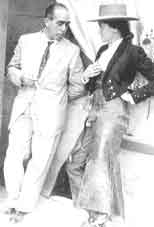 (Left): (Left):
Marcial Lalanda and Conchita Cintrón in the bullring of Cádiz 1950.
Cintrón took
the bullfight world by storm during the 30’s
and 40’s.
(Right): "Morí de Pepe Hillo" by Francisco
Goya, from his "Tauromaquia".
|
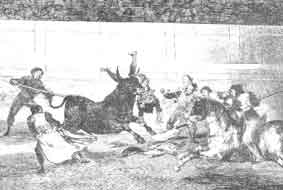 |
Women are
accepted far more in the world of rejoneo
than in bullfighting on foot. Maria Sara, a Parisian, is perhaps the
best of the current contenders, but she cannot compare to the most
famous female rejoneador of
all time, Conchita Cintrón, a Peruvian girl who took the bullfight
world by storm during the 30’s and 40’s.
Today the order and ritual of the rejoneo
is basically unchanged, but there are different styles of fighting.
Purists favour the cool, classical style of Javier Buendía and Fermín Bohórquez, closely resembling
the riding of the traditional Andalusian herdsmen. Other, younger riders
are developing a more spectacular style, in which their horses dance in
time to the pasodoble, execute
split second changes of direction, or perform whirlwind pirouettes in
the face of the bull.
Gines Cartagena, once Spain’s junior dressage
champion, was a master of the new style, and before his death in a
mysterious road accident 3 years ago, had been number one for several
seasons. Now, his nephew Andy, who made his debut aged just 14, is
trying to carry on the family tradition. ”My uncle taught me a great deal,” he said recently ”but his horses are still
teaching me today.”
Perhaps you may have the chance to see these fabulous, noble, rather
arrogant animals prancing in the afternoon sunshine across a ring of
golden sand one day. For me, they embody the spirit of the country. Spain may be called, because of the shape of it’s map, ”The Bullskin”, but
undoubtedly, it’s very
heart contains more than a little of the horse.

Pablo Hermoso
and Cagancho in the Maestranza, Seville. |
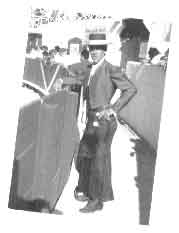
Pablo Hermoso de Mendoza. |
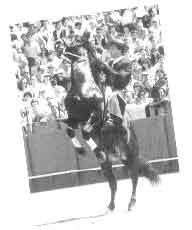
Gines Cartagena. |
|
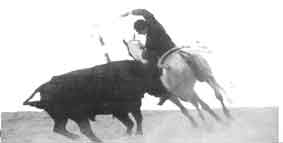
Andy Cartagena
and his "al violín" in the Ronda bullring.
|
|
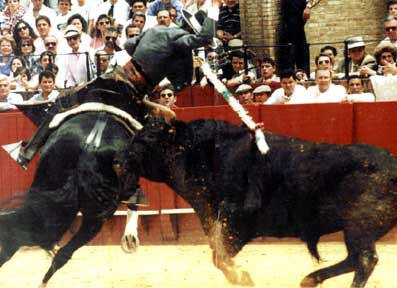
Pablo Hermoso de Mendoza in
Seville - Photo: Ricardo Delgado.
Back to FiB Kulturfront
Tauromaquia
|



 (Left):
(Left): 




